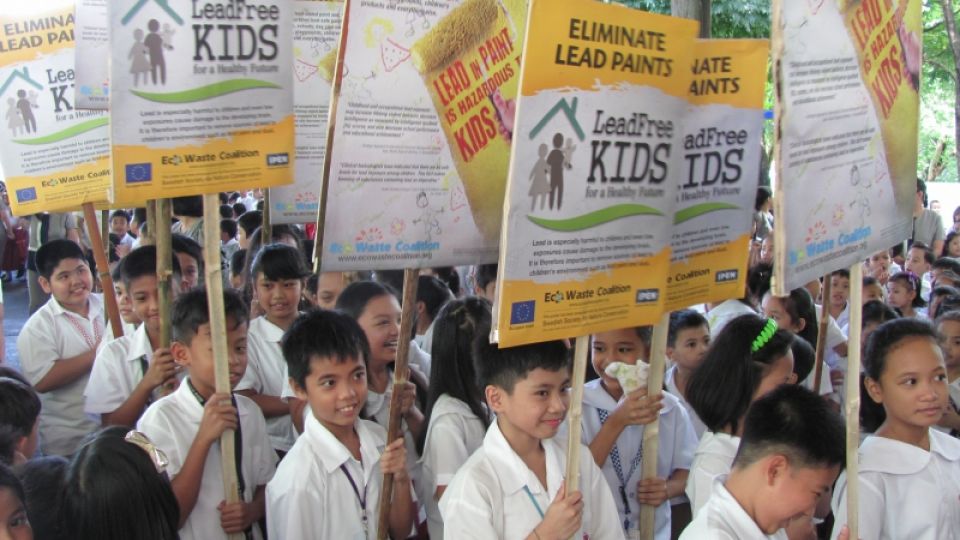The majority of household paints analyzed in seven Asian countries contain unsafe levels of lead; would not meet regulatory standards established in most highly industrialized countries including Czech Republic; and, in a number of cases, have astonishingly high lead content, according to a new report. The Asian Regional Paint Report was released on March 23, 2014 by IPEN, Arnika and partner organizations in the seven countries at the 4th Asian-Pacific Regional meeting of the Strategic Approach to International Chemicals Management (SAICM) convened by the United Nations Environment Programme (UNEP).
“It is well established that there is no safe blood level of lead, especially for children and developing fetuses, so it is very shocking to find such high levels of lead in paints being sold throughout Asia,” said Hemantha Withanage, Project Manager for the IPEN Asian Lead Paint Elimination Project.
“Safe, cost effective alternatives to lead have been in use for many years, so there is absolutely no reason for continuing to add lead to paint products in Asia,” added Manny Calonzo, Southeast Asian Specialist for the IPEN Asian Lead Paint Elimination Project.
The Asian Lead Paint Elimination Project is being implemented by IPEN and its member organization Arnika in seven countries (Bangladesh, India, Indonesia, Nepal, Philippines, Sri Lanka and Thailand) with European Union (EU) funding of EUR 1.4 million.
The Asian Regional Paint Report provides findings from an analysis of 803 oil-based enamel decorative paints: Bangladesh (90 paints), India (250 paints), Indonesia (78 paints), Nepal (49 paints), Philippines (122 paints), Sri Lanka (94 paints), and Thailand (120 paints).
Key findings include:
- More than three-quarters of the paints analyzed contained lead levels above 90 parts per million (ppm) and would not be permitted for sale in most industrialized countries.
- At least a quarter of all paints from all countries contained extremely dangerous levels of lead above 10,000 ppm.
- Overall, brightly colored paints (red, yellow) contained the highest lead levels.
- Major paint brands that contained high levels of lead in previously conducted studies in these same countries now have levels below 90 ppm.
- Paints with low levels of lead were available in all markets at prices comparable to the leaded products, suggesting that the technology exists to produce cost effective, lead-safe products.
- None of the paint cans containing lead stated this on the label or explained the hazards associated with lead.
The effects of low level lead exposure in children are lifelong and irreversible. Evidence of reduced intelligence due to childhood lead exposure has lead the World Health Organization (WHO) to list “lead caused mental retardation” as a recognized disease. Damage to children’s intelligence and mental development occurs, even when there are no obvious or clinical signs of lead poisoning. Recent WHO guidelines indicate that there is no known acceptable lead exposure level
for children.
Children are exposed to lead in paint when painted surfaces deteriorate over time and lead settles into household dusts and soils. Children, particularly children aged 1-6, ingest the lead though normal hand-to-mouth behavior.
A recent study investigated the economic impact of childhood lead exposure on national economies and estimated a total cumulative loss of $977 billion international dollars per year for all low and middle income countries. In Asia, the cumulative loss is estimated to be $699.9 billion or 1.88% of the gross domestic product (GDP). Specific losses in the countries included in the study are: Bangladesh $15.9 billion or 5.9% of GDP; India, $236 billion or 5.2% of GDP; Indonesia $37.9 billion or 3.4% of GDP; Nepal, $1.53 billion or 4% of GDP; Philippines, $15 billion or 3.8% of GDP: Sri Lanka, $1.76 or 1.5% GDP; Thailand, $12.5 billion or 2.1% of GDP.
Oil-based enamel decorative paints were purchased between November 2012 and February 2013 by local NGOs in each of the seven countries. All paints were purchased in local markets and stores frequented by the general public. The 803 paints purchased represented 404 brands. All countries used the same paint sample preparation protocol, and lead paint analysis was conducted by Certottica, a certified laboratory located in Italy. Arnika has has advised and assisted on how to prepare representative and comparible paint samples. "We made good use of our experience with consumer good sampling and testing, and thanks to our membership in the IPEN, spread our expertise with related campaigns abroad," explains Jitka Strakova, a Project Fellow from Arnika, Czech Republic.
IPEN and Arnika partner organizations participating in the study are: Environment and Social Development Organization (Bangladesh); Toxics Link (India); BaliFokus (Indonesia); Center for Public Health and Environmental Development (Nepal); EcoWaste Coalition (Philippines); Centre for Environmental Justice (Sri Lanka); and Ecological Alert and Recovery Thailand (Thailand).







